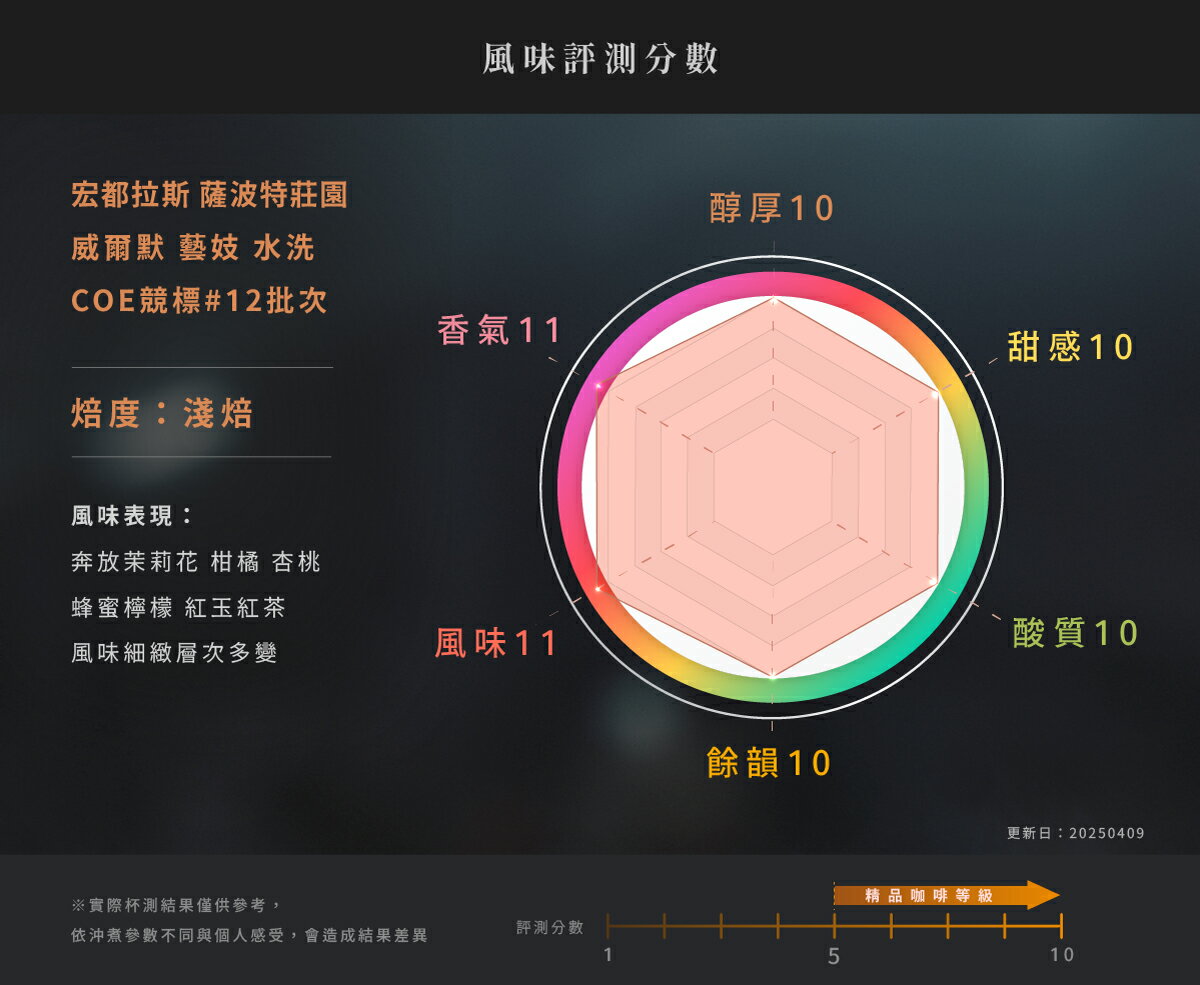

Honduras Intibuca El Zapote Wilmer Alexi Grau Montoya Geisha Washed COE#12
※ This batch was awarded 12th place in the 2024 Honduras Cup of Excellence (COE) competition, receiving a high score of 88.54 points.







Coffee Flavor
The flavors of coffee are derived from the breakdown of various nutrients in the green coffee beans during roasting. Heat causes these compounds to degrade into a variety of aromatic molecular structures, resulting in a wide spectrum of flavors. High-quality coffee beans naturally possess a rich aroma that evolves at different temperatures—high, medium, and low—offering a delightful and nuanced experience worth savoring.
Honduras Intibuca El Zapote Wilmer Alexi Grau Montoya Geisha Washed COE#12
Exuberant Jasmine, Citrus, Apricot, Honey Lemon, Ruby Black Tea; Delicate Flavor with Multiple Layers

El Zapote Farm, situated in the Intibucá region of Honduras at an altitude of approximately 1,800 meters, is managed by Mr. Wilmer Alexi Grau Montoya. The farm is renowned for cultivating the Geisha variety and was awarded 12th place in the 2024 Honduras Cup of Excellence (COE) competition, achieving a high score of 88.54 points.
Its washed-process Geisha coffee is celebrated for its delicate notes of orange blossom, bergamot, jasmine, and honey lemon, showcasing the impact of the region's unique microclimate and fertile soil on coffee quality. Mr. Wilmer's expertise and dedication to quality have earned El Zapote Farm's coffee high acclaim in the international market, making it a sought-after choice for specialty coffee enthusiasts.

Geisha coffee, once named one of the "World's Top 10 Most Expensive Coffees" by Forbes, is a legendary name in the world of specialty coffee. However, there is significant confusion surrounding the Geisha variety, as several genetically distinct plant types are referred to as Geisha, many of which share a similar geographic origin in Ethiopia. Recent genetic diversity analysis conducted by the World Coffee Research confirms that the T2722 variety cultivated in Panama is both unique and consistent. When well-managed in high-altitude regions, this variety is strongly correlated with exceptional cupping quality and is renowned for its delicate floral aroma, jasmine notes, and peach-like fragrance.
The Geisha variety that has thrived in Panama for over 60 years is the T2722 variety. It was originally collected in the 1930s from the coffee forests of Ethiopia. The seeds were sent to the Lyamungu Research Station in Tanzania and later transported to Central America in 1953, where they were documented at the Centro Agronómico Tropical de Investigación y Enseñanza (CATIE) in Costa Rica under the designation T2722. During the 1960s, it was recognized for its tolerance to coffee leaf rust and was distributed by CATIE across Panama. However, due to its fragile branches, it was not favored by farmers and thus was not widely planted. It wasn’t until 2005, when the Peterson family of Boquete, Panama, entered this coffee into the Best of Panama competition and auction, that the variety gained fame. It received exceptional praise and set a record for green coffee auction prices at the time.
Regarding the name "Geisha," the spellings "Geisha" and "Gesha" are often used interchangeably. This is related to phonetic transliteration, as there is no fixed translation from Ethiopian dialects to English. The variety was originally recorded as "Geisha" in planting records. Over the decades, coffee researchers and cultivation databases maintained this spelling, leading to its widespread promotion and use within the coffee industry. The variety was first collected from a mountain in Ethiopia, the name of which is typically translated into English as either "Gesha" or "Geisha."
In recent years, the cultivation of the Geisha variety has gained popularity worldwide, achieving remarkable success in major coffee competitions. This includes regions in Central and South America such as Guatemala, Costa Rica, El Salvador, Colombia, and Peru, where the variety has often been transplanted from Panama's T2722. Additionally, Taiwan has also begun cultivating Geisha in many high-altitude regions. Typically, the higher the elevation, the more enchanting the coffee’s flavor becomes.

(Coffee Processes)
The term "processing methods" refers to the process of transforming ripe red coffee cherries into dried green beans. Each method has its advantages and disadvantages, influenced by the natural environment and the specific needs of the coffee-producing region. As a result, different regions adopt the processing method most suited to their conditions. This batch uses the following three processing methods, described below:
Washed Process
Also known as the wet process, this method involves removing the skin and pulp of the coffee cherries before drying. The seeds are then fermented in water tanks to eliminate the remaining mucilage on their surface, followed by thorough washing and drying under sunlight or with mechanical dryers.
The washed process produces a cleaner and crisper flavor profile compared to the natural process. Coffees processed this way typically have lighter body, brighter acidity, and distinct fruit flavors. This method is often associated with specialty coffee due to its clarity and vibrant flavor expression.





JUSTIN INTERNATIONAL FOOD ENTERPRISE CO., LTD.
Tel: +886-3-358-6611
1st Floor, No. 30, Lane 120, Daxing Road, Taoyuan District, Taoyuan City
▶This product is covered by a NT$10 million product liability insurance.
▶Food Industry Registration Number: F-165601955-00000-0
▶ Our company’s cupper is certified as a CQI International Coffee Quality Appraiser.



Recommended Products

